
A cartoon, or preliminary drawing, for the sign that hung in front of Thorley’s studio-shop for many years. Opaque paint on paper. 26" x 33". Thorley realized the importance of advertising, and his papers reveal many drawings and sketches for signs. Some incorporate his wife’s name—Edith—instead of his. Even though this sign could not have been made before 1950, it reflects, as do many of his later ceramics, his interest in the designs of his earlier life, from the 1920s and 1930s. The original sign is in the collection of Fred Miller. (Unless otherwise noted, all illustrated objects are in the author’s collection and all photos are by Gavin Ashworth.)
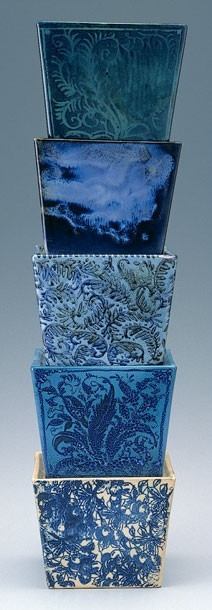
Jardinieres or square bricks, Palin Thorley, Williamsburg, Virginia, ca. 1960. Whiteware. 4" x 5" x 5". The bases have Thorley’s experimental marks and his monogram

Trenthan Woods Autumn, by John Thorley, 1904. Watercolor on paper. 14" x 20". “And my father dropped the pottery now and he’s painting—painting landscape. . . . [He] would go sketching, mostly in Dovedale, in Derbyshire, all the ancient places around Staffordshire. It is beautiful country there, most beautiful in the world. There’s nothing to touch it anywhere—I still think that. So I would go to carry his traps, which he called them, which was a sketching umbrella to keep the sun off of him when he painted his watercolors, his paint boxes, and so forth, and maybe some lunch in a bag.”
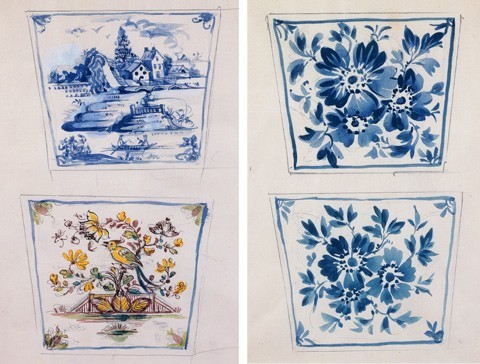
Drawings for square bricks, Palin Thorley, ca. 1960. Pencil and watercolor on paper. Each 7" x 9 1/2".

Jardinieres or square bricks, Palin Thorley, Williamsburg, Virginia, ca. 1960. Whiteware. 4" x 5" x 5". The bases have Thorley’s experimental marks and his monogram.

Plaque, Palin Thorley, Williamsburg, Virginia, ca. 1955. Whiteware. W. 6". (Courtesy, Clark Taggart Collection.)

Drawings for plates, Palin Thorley, ca. 1930–1940. Watercolor on cardboard. 10" x 10".

Drawings for plates, Palin Thorley, ca. 1930–1940. Watercolor on cardboard. 10" x 11".

Covered jars, Wedgwood, Burslem, England, 1914. Whiteware. Left: H. 4". Signed on interior bottom: “J. P. Thorley 1914.” Impressed on exterior bottom: “WEDGWOOD.” (Another covered jar with the same mark is at Swem Library, College of William and Mary.) Right: H. 3 3/4". Unsigned. Mark on bottom: printed Portland vase and “Wedgwood England.”

Sauceboat, Wedgwood, Burslem, England, 1953. Creamware. L. 9". This design, known as the Edme pattern, was created about 1906 and is still in production at Wedgwood. In an interview Thorley mentioned that he “helped design the Edme pattern,” and in a draft of a letter to David Buten ca. 1973 he wrote, “Edme Pattern: I remember the advent of this fine shape—Mr. Goodwin had me do a number of detail drawings for various purposes and for Mr. Austin to model from. I used to sit watching Mr. Austin at work on it.”
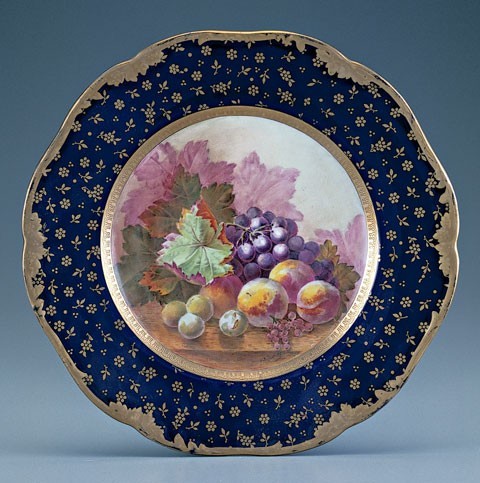
Plate, Wedgwood, Burslem, England, 1914. Bone china. D. 9". Mark on reverse: printed Portland vase above “Wedgwood/England.” Signed and dated lower right of scene: “J. P. Thorley / 1914.”
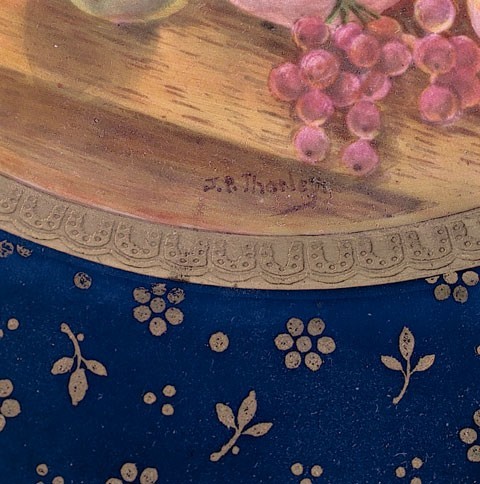
Detail of the signature on the plate illustrated in fig. 10.
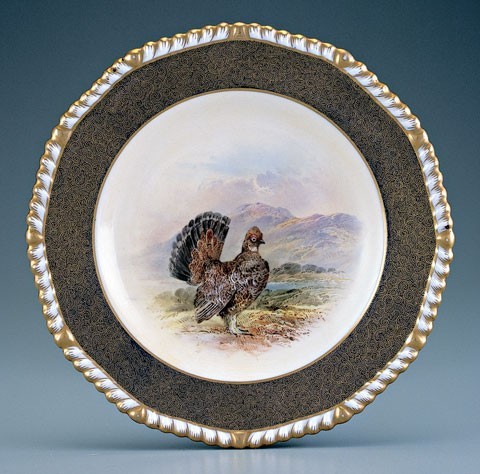
Plate, Wedgwood, Burslem, England, ca. 1914. Bone china. D. 9". Inscribed by hand, on reverse: “Dusty Grouse.” Mark on reverse: printed Portland vase above “Wedgwood / England.”
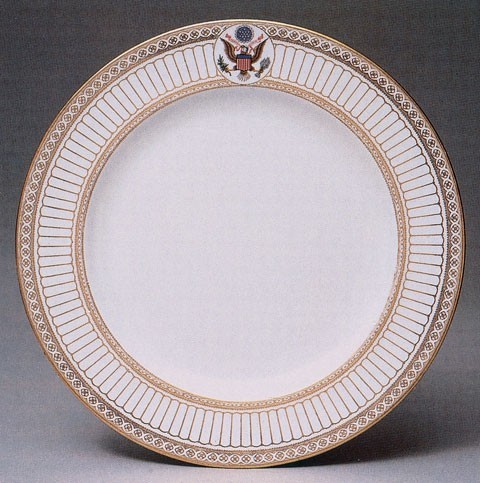
Theodore Roosevelt plate, Wedgwood, Burslem, England, 1906– 1914. Bone china. D. 10 1/2''. (Collection of the White House, Washington, D.C.) The Theodore Roosevelt service was made by Wedgwood for the White House during Roosevelt’s presidency (1901–1909).
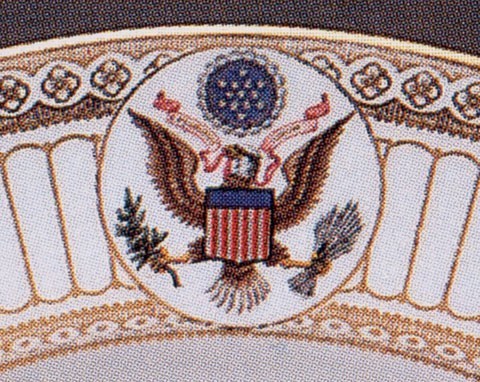
Theodore Roosevelt plate, Wedgwood, Burslem, England, 1906– 1914. Bone china. D. 10 1/2''. (Collection of the White House, Washington, D.C.) The Theodore Roosevelt service was made by Wedgwood for the White House during Roosevelt’s presidency (1901–1909).
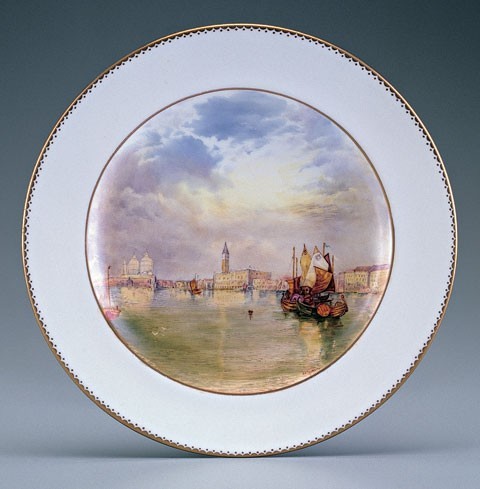
Plate, Wedgwood, Burslem, England, 1906–1914. Bone china. D. 9". Signed: “J. P. Thorley.” Mark on reverse: printed Portland vase above “Wedgwood / England.” Thorley started to work as a painter at Wedgwood in 1906. His first “apprentice” plate was dated Nov. 4, 1906. This plate shows a view of Venice. Thorley kept it in his possession for many years, and it was found in 1985 when his studio and house were cleared.

Plate, Wedgwood, Burslem, England, 1914. Bone china. D. 9 1/4". Signed lower right: “J P Thorley 1914.” Mark on reverse: printed Portland vase. Thomas Allen, a ceramic painter and head of the painting department at Wedgwood, prepared a sketch book of his original drawings and watercolors which remained at the factory when he left, a short time before Thorley went to apprentice there. Among the illustrations Thorley copied from Allen’s book are this one, of a young Scot playing a bagpipe, and the lass in a field on the plate illustrated in fig. 16.
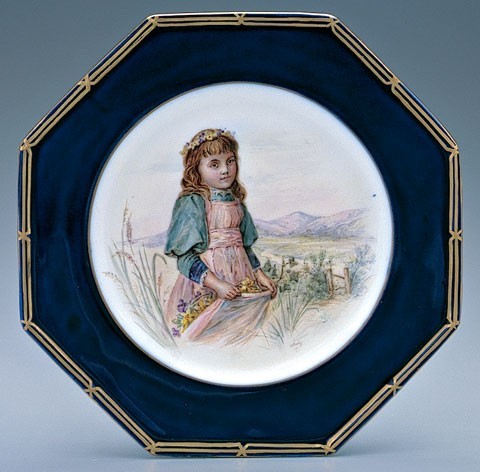
Plate, Wedgwood, Burslem, England, 1914. Bone china. D. 9 1/4". Signed lower right: “J P Thorley 1914.” Mark on reverse: printed Portland vase. (Collection of the Swem Library, College of William and Mary.) Thorley copied this image from Thomas Allen’s book; see fig. 15.
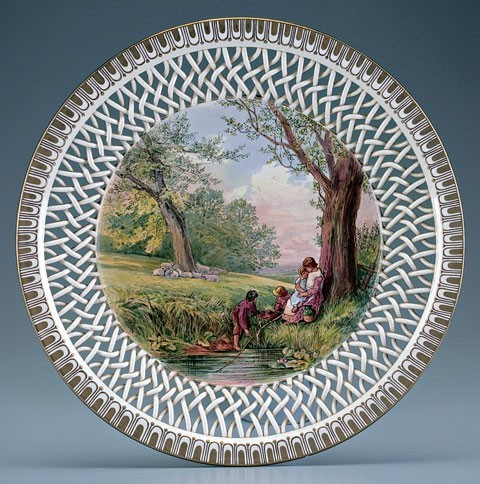
Plate, Wedgwood, Burslem, England, 1914. Whiteware. D. 9 1/4". Signed and dated lower right: “J. P. Thorley, 1914.” Impressed on reverse: Wedgwood mark. Thorley painted two plates with a basketwork rim. This one, made of earthenware rather than the usual bone china, remained in his collection until he died.
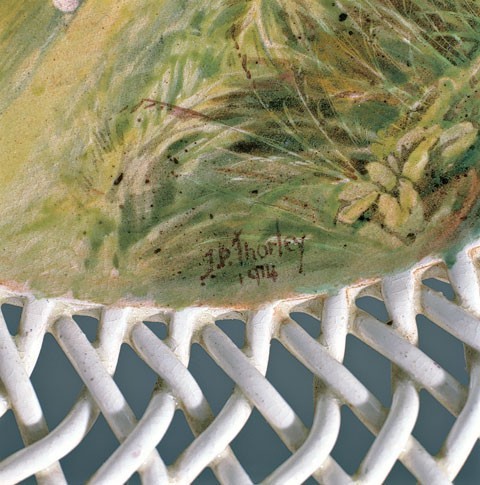
Detail of the signature on the plate illustrated in fig. 17.
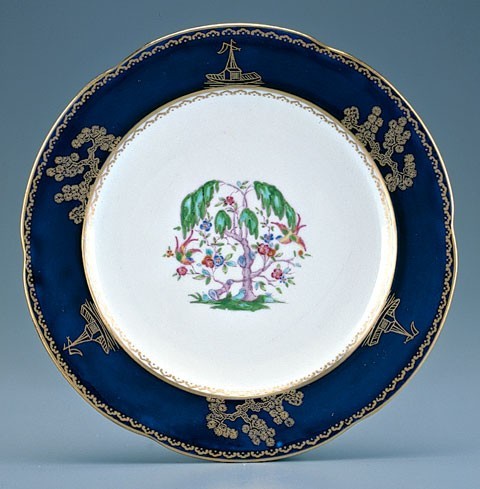
Plate, New Chelsea Porcelain Co., Longton, Staffordshire, England, ca. 1923. Bone china. D. 8 1/2". Mark on reverse: New Chelsea mark incorporating an anchor. It has been said that the New Chelsea mark was not used until “c. 1936+,” which suggests that the mark was either used much earlier than recorded or, more likely, that Thorley’s designs continued to be used after he left the factory. The plate was found in Thorley’s studio.
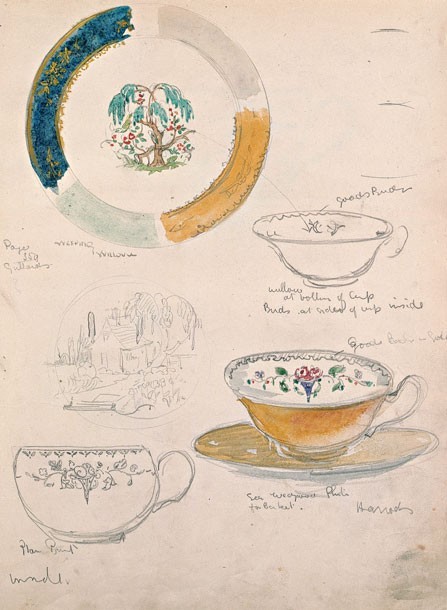
Page from Thorley’s drawing book illustrating the design of the plate illustrated in fig. 19. Thorley called this design Weeping Willow. A line drawn from the tree on the plate to the uncolored sketch of the cup to the right accompanied instructions—“willow at bottom of cup, birds at sides of cup inside”—that agree with the existing cup except that the separate birds are on the exterior.
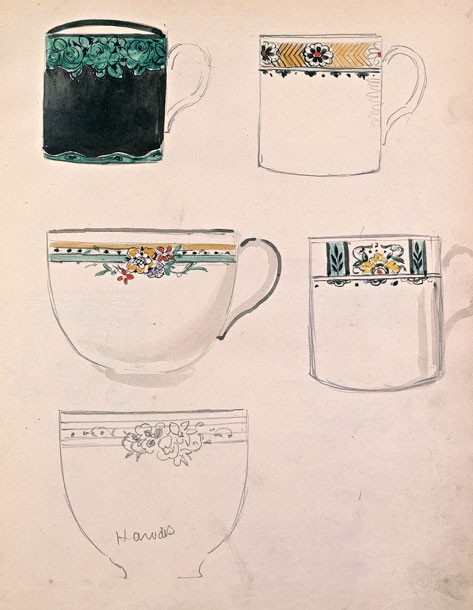
11 Pages from a notebook of Thorley’s sketches and watercolors showing ceramic objects such as wash pitchers and basins, cups and saucers, and plates. Many are annotated “printed” or “painted” and include information regarding color, size, estimated cost, possible markets (such as “Harrods”), and the sources of—or inspirations for—his design (for example, “see House & Garden Dec 1920 page 26”). Based on the styles, the relationships between the drawings and examples made at New Chelsea, and a small clipping in the book from a London newspaper dated 1923, I believe Thorley used this drawing book during his years at New Chelsea.
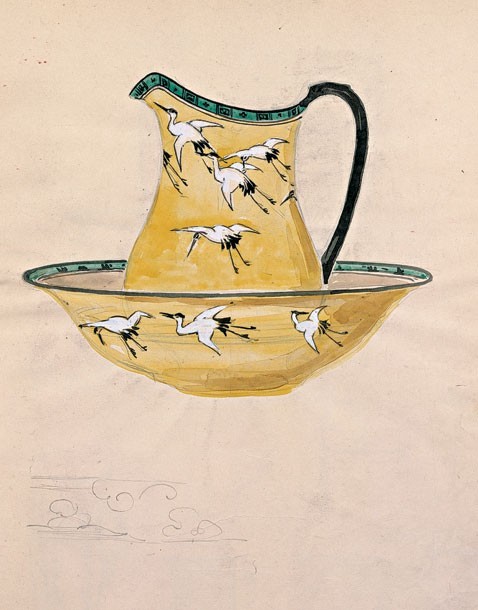
11 Pages from a notebook of Thorley’s sketches and watercolors showing ceramic objects such as wash pitchers and basins, cups and saucers, and plates. Many are annotated “printed” or “painted” and include information regarding color, size, estimated cost, possible markets (such as “Harrods”), and the sources of—or inspirations for—his design (for example, “see House & Garden Dec 1920 page 26”). Based on the styles, the relationships between the drawings and examples made at New Chelsea, and a small clipping in the book from a London newspaper dated 1923, I believe Thorley used this drawing book during his years at New Chelsea.
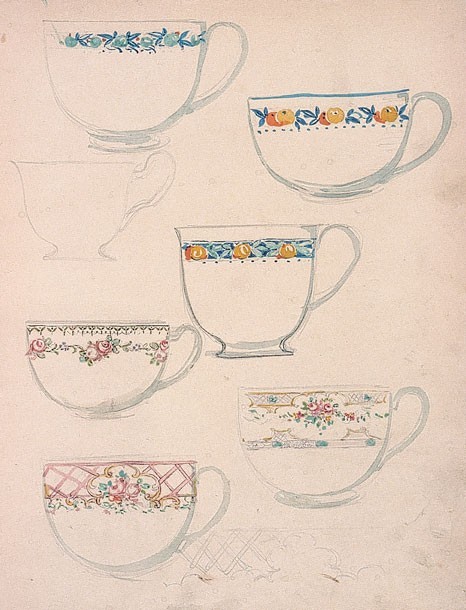
11 Pages from a notebook of Thorley’s sketches and watercolors showing ceramic objects such as wash pitchers and basins, cups and saucers, and plates. Many are annotated “printed” or “painted” and include information regarding color, size, estimated cost, possible markets (such as “Harrods”), and the sources of—or inspirations for—his design (for example, “see House & Garden Dec 1920 page 26”). Based on the styles, the relationships between the drawings and examples made at New Chelsea, and a small clipping in the book from a London newspaper dated 1923, I believe Thorley used this drawing book during his years at New Chelsea.
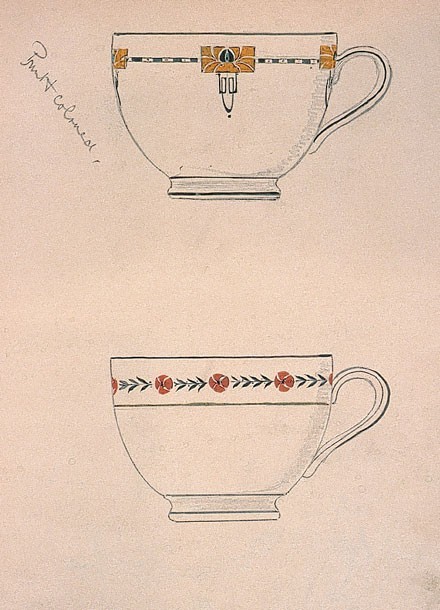
11 Pages from a notebook of Thorley’s sketches and watercolors showing ceramic objects such as wash pitchers and basins, cups and saucers, and plates. Many are annotated “printed” or “painted” and include information regarding color, size, estimated cost, possible markets (such as “Harrods”), and the sources of—or inspirations for—his design (for example, “see House & Garden Dec 1920 page 26”). Based on the styles, the relationships between the drawings and examples made at New Chelsea, and a small clipping in the book from a London newspaper dated 1923, I believe Thorley used this drawing book during his years at New Chelsea.

11 Pages from a notebook of Thorley’s sketches and watercolors showing ceramic objects such as wash pitchers and basins, cups and saucers, and plates. Many are annotated “printed” or “painted” and include information regarding color, size, estimated cost, possible markets (such as “Harrods”), and the sources of—or inspirations for—his design (for example, “see House & Garden Dec 1920 page 26”). Based on the styles, the relationships between the drawings and examples made at New Chelsea, and a small clipping in the book from a London newspaper dated 1923, I believe Thorley used this drawing book during his years at New Chelsea.
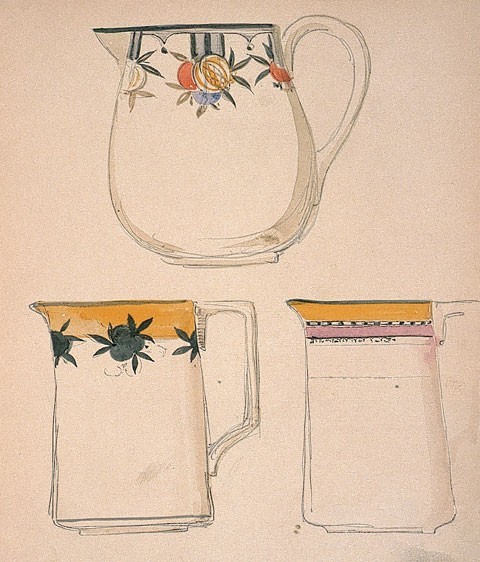
11 Pages from a notebook of Thorley’s sketches and watercolors showing ceramic objects such as wash pitchers and basins, cups and saucers, and plates. Many are annotated “printed” or “painted” and include information regarding color, size, estimated cost, possible markets (such as “Harrods”), and the sources of—or inspirations for—his design (for example, “see House & Garden Dec 1920 page 26”). Based on the styles, the relationships between the drawings and examples made at New Chelsea, and a small clipping in the book from a London newspaper dated 1923, I believe Thorley used this drawing book during his years at New Chelsea.
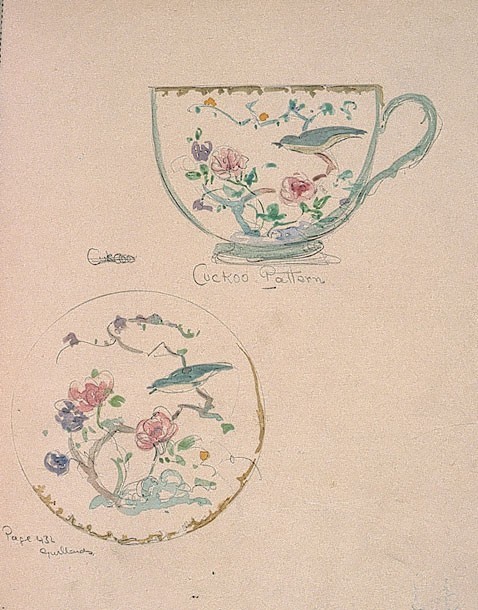
11 Pages from a notebook of Thorley’s sketches and watercolors showing ceramic objects such as wash pitchers and basins, cups and saucers, and plates. Many are annotated “printed” or “painted” and include information regarding color, size, estimated cost, possible markets (such as “Harrods”), and the sources of—or inspirations for—his design (for example, “see House & Garden Dec 1920 page 26”). Based on the styles, the relationships between the drawings and examples made at New Chelsea, and a small clipping in the book from a London newspaper dated 1923, I believe Thorley used this drawing book during his years at New Chelsea.
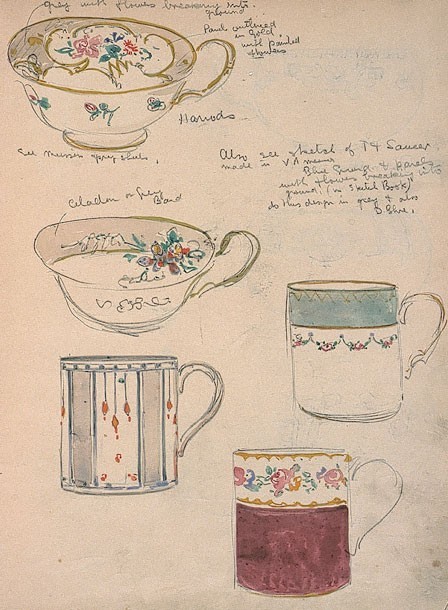
11 Pages from a notebook of Thorley’s sketches and watercolors showing ceramic objects such as wash pitchers and basins, cups and saucers, and plates. Many are annotated “printed” or “painted” and include information regarding color, size, estimated cost, possible markets (such as “Harrods”), and the sources of—or inspirations for—his design (for example, “see House & Garden Dec 1920 page 26”). Based on the styles, the relationships between the drawings and examples made at New Chelsea, and a small clipping in the book from a London newspaper dated 1923, I believe Thorley used this drawing book during his years at New Chelsea.
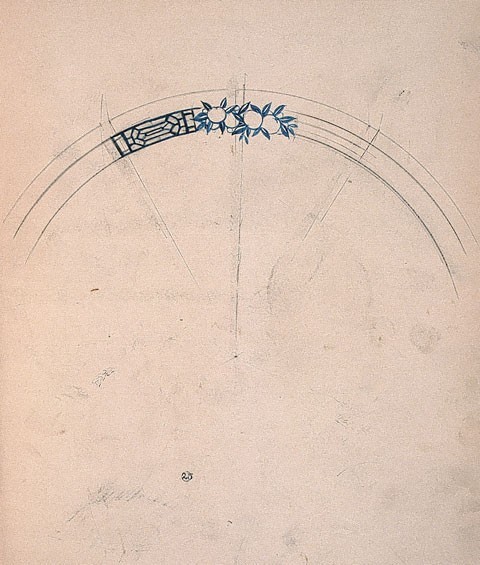
11 Pages from a notebook of Thorley’s sketches and watercolors showing ceramic objects such as wash pitchers and basins, cups and saucers, and plates. Many are annotated “printed” or “painted” and include information regarding color, size, estimated cost, possible markets (such as “Harrods”), and the sources of—or inspirations for—his design (for example, “see House & Garden Dec 1920 page 26”). Based on the styles, the relationships between the drawings and examples made at New Chelsea, and a small clipping in the book from a London newspaper dated 1923, I believe Thorley used this drawing book during his years at New Chelsea.
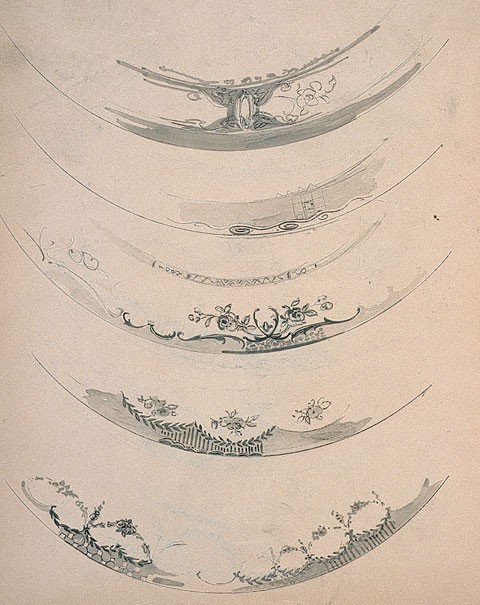
11 Pages from a notebook of Thorley’s sketches and watercolors showing ceramic objects such as wash pitchers and basins, cups and saucers, and plates. Many are annotated “printed” or “painted” and include information regarding color, size, estimated cost, possible markets (such as “Harrods”), and the sources of—or inspirations for—his design (for example, “see House & Garden Dec 1920 page 26”). Based on the styles, the relationships between the drawings and examples made at New Chelsea, and a small clipping in the book from a London newspaper dated 1923, I believe Thorley used this drawing book during his years at New Chelsea.
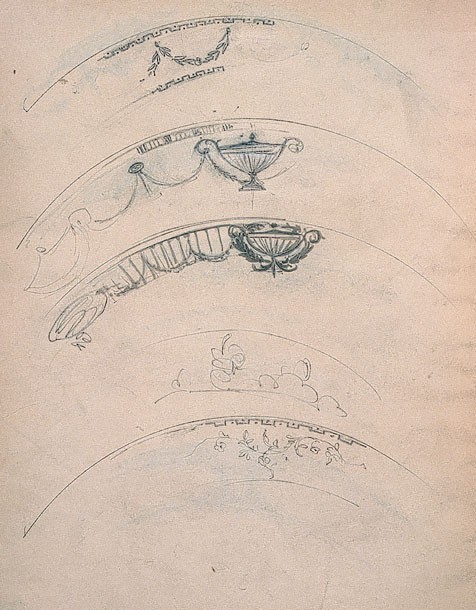
11 Pages from a notebook of Thorley’s sketches and watercolors showing ceramic objects such as wash pitchers and basins, cups and saucers, and plates. Many are annotated “printed” or “painted” and include information regarding color, size, estimated cost, possible markets (such as “Harrods”), and the sources of—or inspirations for—his design (for example, “see House & Garden Dec 1920 page 26”). Based on the styles, the relationships between the drawings and examples made at New Chelsea, and a small clipping in the book from a London newspaper dated 1923, I believe Thorley used this drawing book during his years at New Chelsea.
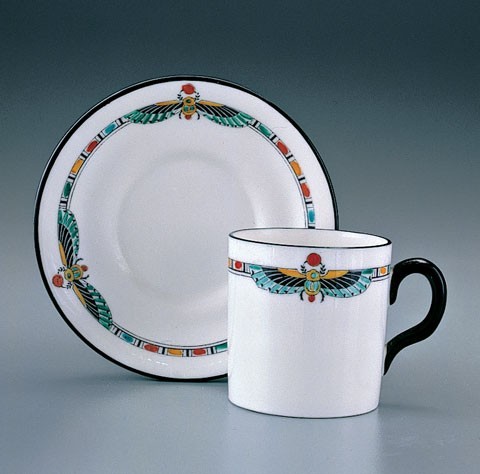
Cup and saucer, New Chelsea Porcelain Co., Longton, Staffordshire, England, ca. 1923. Mark on reverse: Chelson mark. Inscribed: “Henwood Johannesburg.” These pieces display Egyptian-motif decoration, including a scarab, and a Chelson mark that was used in the early 1920s. They were made for Henwood, a department store in Johannesburg, South Africa.
A complete service in this design survives with the inscription “W. Savill & Co. Porcelain House, 22 Oxford Street, W1,” along with the mark. Thorley stated in an interview: “So I made my designs and then went up to London and I went to see Mr. Savill of Savill and Company, Oxford Street. Mr. Savill had a very beautiful china store there, china and glass. So when I showed him these Egyptian patterns, he picked one out and thought it was beautiful. He bought it. I reproduced it at the plant and shipped it to Savill . . . who put a big window display . . . right on Oxford Street, London.”
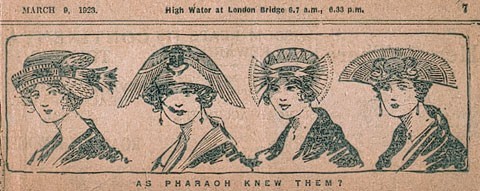
Clipping from a London newspaper, March 8, 1923. This clipping illustrating women’s hats in the Egyptian style was found in Thorley’s New Chelsea sketchbook. Note the scarab on the second hat from the left.
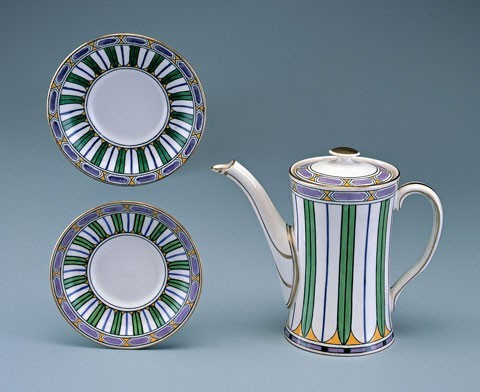
Partial coVee service, New Chelsea Porcelain Co., Longton, StaVordshire, England, ca. 1923. Whiteware. H. of coVee pot: 5 3/4". Mark: New Chelsea. The design of these pieces found in the attic at Thorley’s shop was influenced by the discovery in 1923 of the tomb of the Eighteenth Dynasty pharaoh Tutankhamun (r. 1333–1323 b.c.), which had launched an international revival of Egyptian motifs.
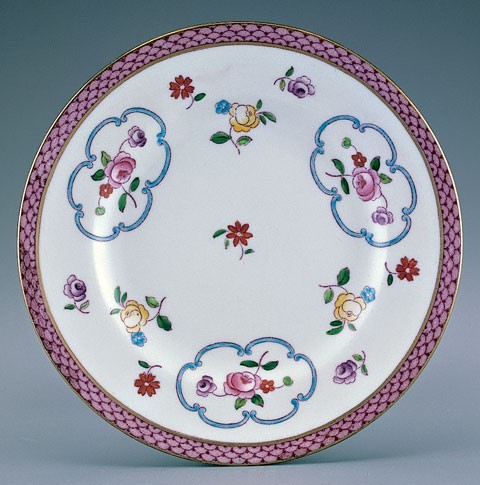
Plate, New Chelsea Porcelain Co., Longton, Staffordshire, England, ca. 1923. Whiteware. D. 7". The scale decoration on the edge of the plate’s rim is in a style that was popular in the eighteenth century at Worcester and other English porcelain factories.
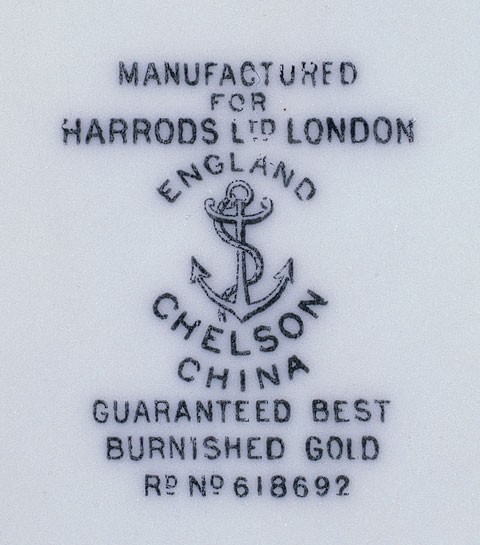
Detail of the mark used on the plate illustrated in fig. 25. Part of the Chelson mark on the plate states “MANUFACTURED / FOR / HARRODS LTD LONDON / ENGLAND.” Thorley suggests in his sketch book that some of the pieces he illustrated would be appropriate to offer to Harrods, a London department store.
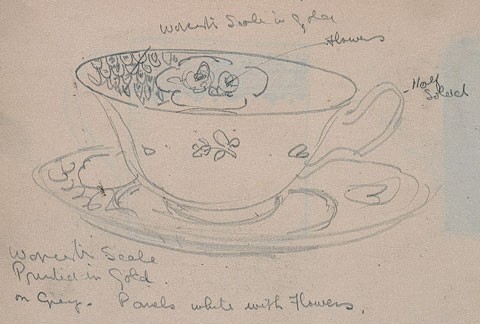
A teacup drawing from Thorley’s book showing the Worcester Scale decoration used on the plate illustrated in fig. 25. Both the scale decoration and the flowers in the ogee reserves can be seen on the drawing of a related teacup in the drawing book Thorley used during the years he was at New Chelsea. A note above the drawing (and pointing to it) reads, “Worcester Scale” and, below, “Worcester Scale Printed in Gold on Gray—Panels white with Flowers.” Blue scale was most popular in the eighteenth century, but pink scale and gold scale were also produced.
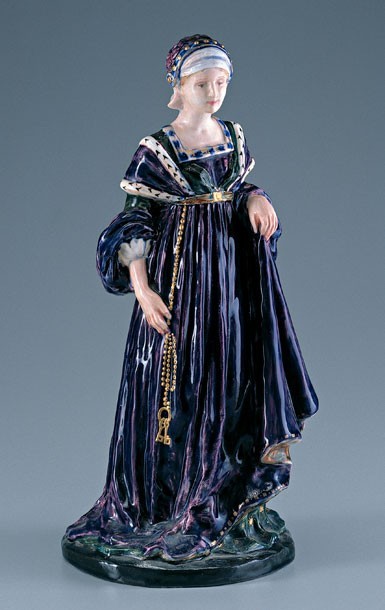
“Chatelaine,” J. Palin Thorley, Staffordshire, England, 1921. Bone china. H. 12". Signed; see fig. 29 for detail. This figure of a chatelaine in medieval dress was made during either Thorley’s last days at Simpsons or his early days as head of the art department at the New Chelsea Porcelain Co. It is most likely he created this on his own, not as part of the factory’s production, because both Simpsons and New Chelsea specialized in dinner ware and because so few examples of this figure appear to have been made. Stories that Thorley made only three of them—one of which was admired by and thus given to Queen Mary—cannot be verified, although he does say that the figure was admired by her. Thorley must have kept the mold, for a green (unfired) example, with head missing, was found in his studio in 1986 (see fig. 30). A letter to him from a customer, dated December 8, 1971, states, “We are eagerly awaiting the Chatelaine figurine. It will be our most prized possession,” which indicates that he promised to produce one for a client at that late date. In the Thorley papers there is an early photograph of the chatelaine—which may or may not be this example—that has the unexplained date “1917” written on the back.
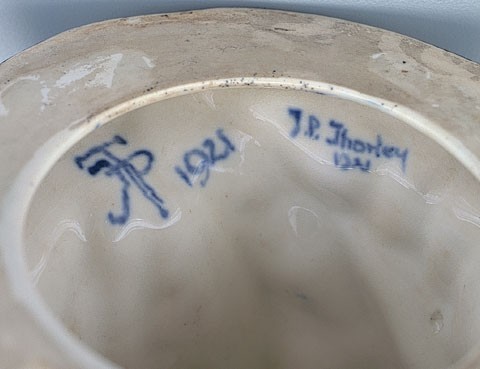
Detail of the marks on the base of the chatelaine illustrated in fig. 28. Thorley marked the figure twice, once with his monogram and date, once with his name and date.
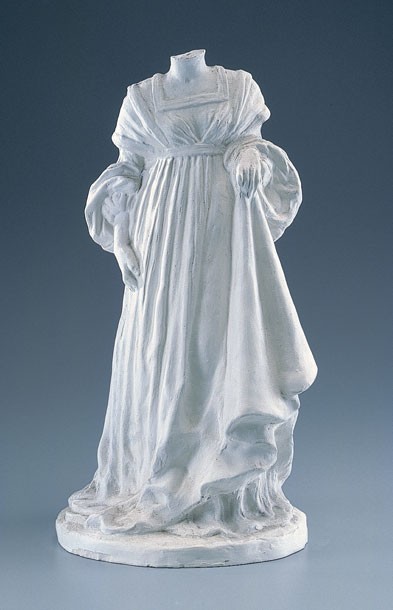
“Chatelaine,” J. Palin Thorley, Williamsburg, Virginia, ca. 1970. Greenware. This unfinished figure, with its head missing, was made from the same mold that was found in Thorley’s studio in 1986.

Plates, Charles Allerton & Sons, Longton, Stoke-on-Trent, Staffordshire, England, ca. 1925. Left: D. 7 1/2". Right: D. 6 1/2". These examples, which bear the Allerton mark on the reverse, were found in the attic of Thorley’s studio-home. They were kept with other pieces that had been made in potteries where he had worked and whose designs were confirmed to be by him. Nevertheless, the attribution to Thorley of these particular plates remains tenuous.
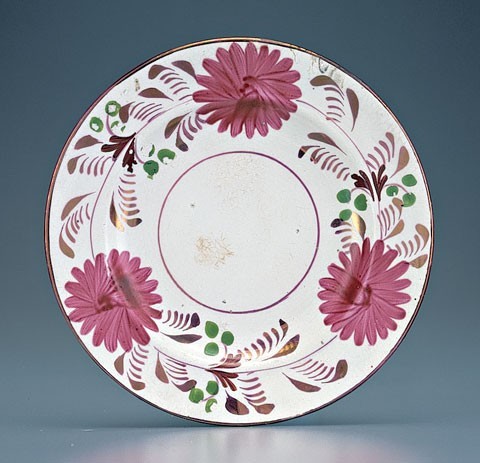
Plate, Charles Allerton & Sons, Longton, Stoke-on-Trent, Staffordshire, England, ca. 1925. Whiteware. D. 5 1/2". This unmarked plate was found in Thorley’s attic, along with pieces designed by him. Plates are recorded in this pattern that are impressed on the reverse with numbers ranging from 24 to 40, indicating that the plates—and most likely the decoration—were made from at least 1924 to 1940, both during and after Thorley’s stint at Allerton. It is possible that this is one of the patterns that Thorley had Mrs. Woolley reestablish.
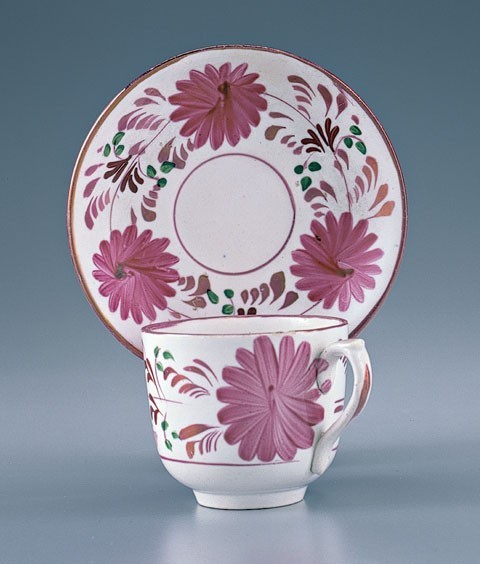
Cup and saucer, Charles Allerton & Sons, Longton, Stoke-on-Trent, Staffordshire, England, ca. 1925. Whiteware. Cup: H. 2 1/2". Saucer: D. 5". Mark on saucer: “Imperial China, Charles Allerton& Sons, England.” The mark is one that was used during Thorley’s tenure.
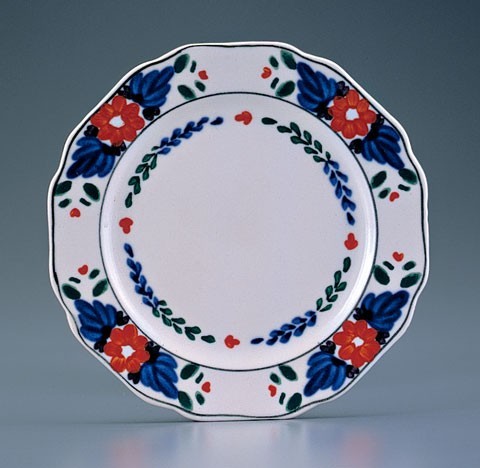
Plate, Charles Allerton & Sons, England, ca. 1925. Whiteware. D. 5 3/4". Mark: “A” within a wreath. It is possible that the term Thorley ware, which appears as part of the Allerton mark on this plate, does not refer to Palin Thorley, as the design is less sophisticated than ones usually attributed to him. The mark (see fig. 35) is said to have been used beginning ca. 1929; Thorley left Allerton in 1927. It is possible that the mark was used earlier than recorded. As the only non-family member on the board, Palin Thorley clearly was important to the Allerton pottery. Moreover, it is unlikely that another potter named Thorley would have had ware named for him, particularly so soon after Palin left. Palin’s younger brother Noel is perhaps a possibility, although whether he worked at Allerton is not known. According to a November 1951 article in the Pottery Gazette and Glass Trade Review, in about 1945 Noel opened a pottery in which he was a “small fancyware potter.”

Detail of the mark used on the plate illustrated in fig. 34.

Photograph of Palin Thorley, taken in New York City in the mid- to late 1930s. (Courtesy, Thorley Papers, Swem Library, College of William and Mary.)
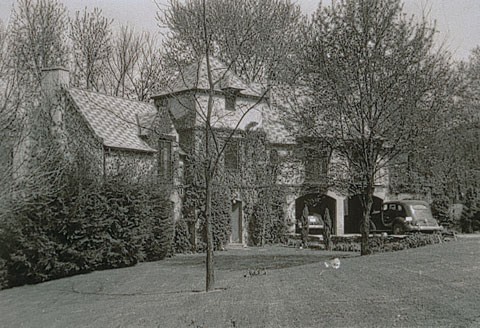
Photograph of the Thorley residence, Parkway, East Liverpool, Ohio. Inscribed on the back: “Residence of J. P. THORLEY (3 acres) land next to Country Club.” (Courtesy, Thorley Papers, Swem Library, College of William and Mary.)

Photograph of Edith Bolling Thorley, Palin’s wife, in the garden of their home in East Liverpool, ca. 1920. (Courtesy, Thorley Papers, Swem Library, College of William and Mary.) The Thorleys were married in 1916, during World War I, and were devoted to each other until her death, in 1975, an event from which he never recovered. In my last visits with him, during any break in the conversation, he would shake his head and repeat, “Oh, my poor Edith.”

Illustrated in Pottery and Glass Salesman (March 1941) are the three plates shown here. The caption reads: “The next important development after the introduction of the Ivory body was the umbertone body, which was the first narrow-rim plate ever jiggered in America. The patterns illustrated here are ‘Strafford,’ ‘Duo-Bloom,’ and ‘Palm.’”
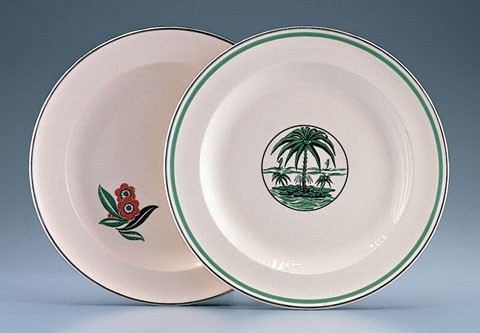
Leigh Ware dinner plates, Leigh Potters, Alliance, Ohio, 1930. Whiteware. D. 9". Left: Duo-Bloom design. Marks: “Umbertone” and the Leigh mark. Right: Palm, PT-115 design. Mark: Leigh mark. These plates were found in Thorley’s attic.
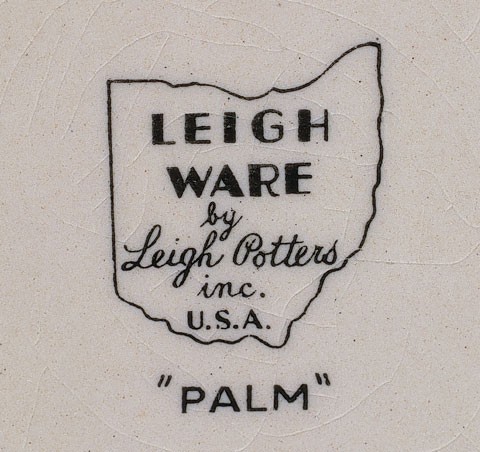
Detail of the mark used on the Palm plate illustrated in fig. 40, right.
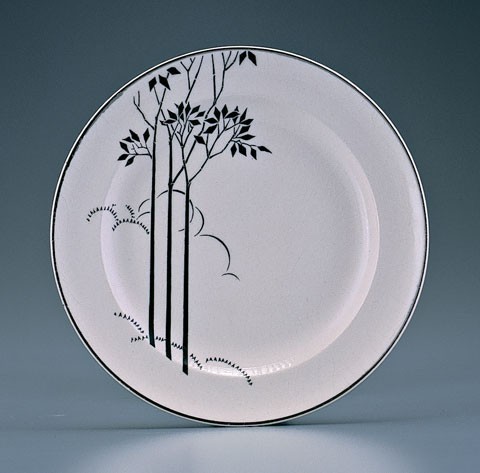
Nouvelle plate, Knowles, Taylor, and Knowles, American Chinaware Corp., East Liverpool, Ohio, 1930. Whiteware. D. 6". Mark: “K. T. & K.”; “4 8 30” (possibly date of manufacture). Taylor, Smith & Taylor was one of the small potteries incorporated into the American Chinaware Corp. The Nouvelle form, attributed to Thorley, is decorated here with the Top o’ the Hill pattern and is reproduced in an article about the Nouvelle shape (see fig. 43). The plate was found in Thorley’s attic.
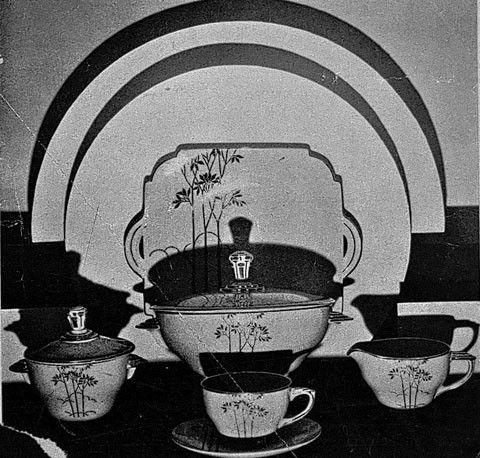
Clipping, “American Chinaware Corp. Has Many New Designs,” China, Glass, and Lamps, June 1930, p. 19, ill. (Courtesy, Thorley Papers, Swem Library, College of William and Mary.) This article contains a discussion of the Nouvelle form and shows the plate that is illustrated in fig. 42.
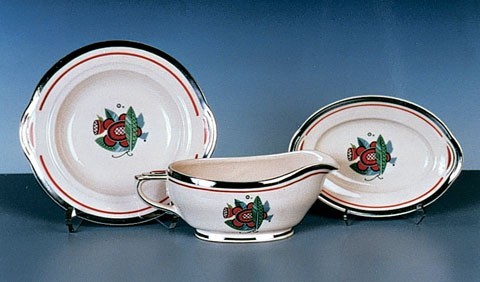
Partial Monte Carlo service, American Chinaware Corp., East Liverpool, Ohio, 1930. Whiteware. D. largest plate 9". L. sauceboat 8 1/4". Marks: “AMERICAN CHINAWARE CORP.” encircling the overlapping monogram “ACC”; “H-8-30” (possible date of manufacture). (Courtesy, Jo Cunningham Collection.)

Partial Monte Carlo service, American Chinaware Corp., East Liverpool, Ohio, 1930. Whiteware. D. largest plate 9". L. sauceboat 8 1/4". Marks: “AMERICAN CHINAWARE CORP.” encircling the overlapping monogram “ACC”; “H-8-30” (possible date of manufacture). (Courtesy, Jo Cunningham Collection.)

Clipping, “American Chinaware Corp. Has Many New Designs,” China, Glass, and Lamps, June 1930, p. 30, ill. (Courtesy, Thorley Papers, Swem Library, College of William and Mary.)

Poinciana plate, American Chinaware Corp., Sebring, Ohio, ca. 1930. Whiteware. D. 9". The shape of this plate is identical to the two with the Leigh marks (see figs. 40, 41) as well as the Nouvelle examples (see fig. 42). The name on the reverse, “Poinciana,” is not among those listed by Harvey Duke in Official Price Guide to Pottery and Porcelain (1995), pp. 42–45, as appearing on that shape. Like most of the others illustrated from this period, this plate was found in Thorley’s attic.

Detail of the printed mark on the plate illustrated in fig. 46: “Amerce [possibly Amercé] / DINNERWARE / AMERICAN CHINAWARE CORP.” ; and “POINCIANA” (handwritten). The printed mark is very rare. No date letter is found.

English Abbey plates, Taylor, Smith & Taylor, Chester, West Virginia, 1933–1950. Whiteware. D. 9 1/4". These
dinner plates show the English Abbey design in three different colors and on three different shapes. All are marked “J. Palin Thorley” at the lower right edge of the design. The red print is on Thorley’s Laurel shape and marked “English Abbey” on the reverse. The blue print is on the Garland shape and is also marked “English Abbey” on the reverse. The green print is on the Fairway shape and is not marked

Detail of Thorley’s signature from the plate illustrated at the center in fig. 48.
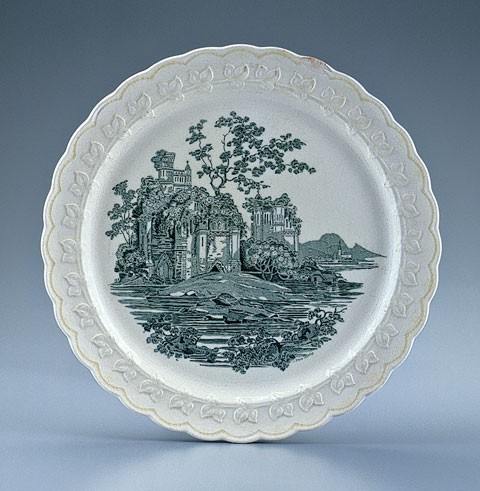
Castle plate, Taylor, Smith & Taylor, Chester, West Virginia, 1933– 1940. Whiteware. D. 9". Thorley’s signature appears below the Castle design on this Garland plate, although the Garland shape is not associated with Thorley.
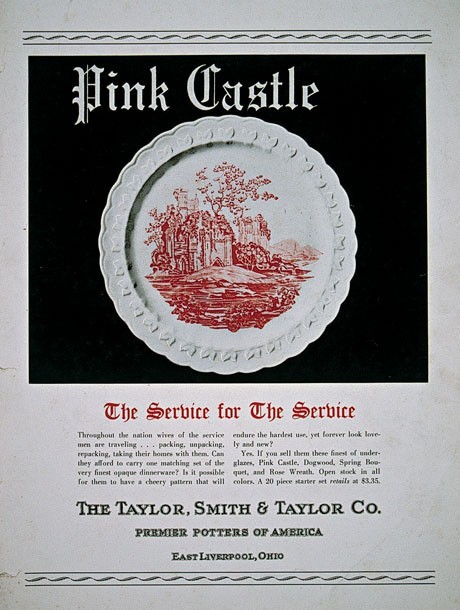
Advertisement, Pottery and Glass Salesman, June 1940, p. 3. (Courtesy, Thorley Papers, Swem Library, College of William and Mary.) This advertisement was to promote Taylor, Smith & Taylor’s Pink Castle line.
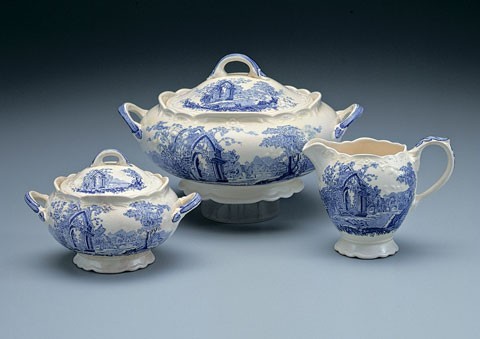
English Abbey sugar, tureen, and creamer, Taylor, Smith & Taylor, Chester, West Virginia, 1933–1950. Whiteware. H. of tureen 5 1/2", sugar 4", creamer 4". Mark: “English Abbey.” (Courtesy, Clark Taggart Collection.) These serving pieces have the Fairway form, which has not been associated with any designer.
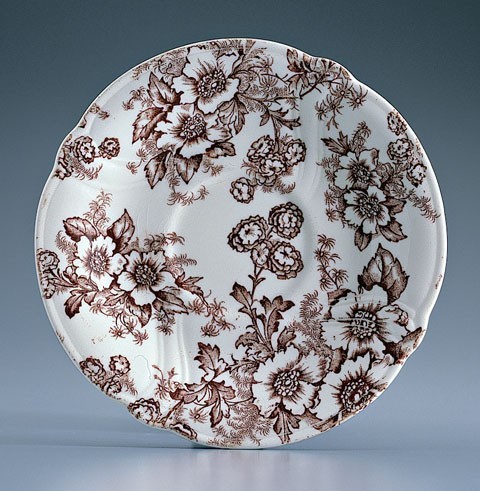
Dogwood saucer, Taylor, Smith & Taylor, Chester, West Virginia, 1941. Whiteware. D. 6 1/4". Marks: “Taylor, Smith & Taylor, U.S.A.” within a wreath; “1941.” Vogue form. Thorley’s monochrome patterns are less common in brown.
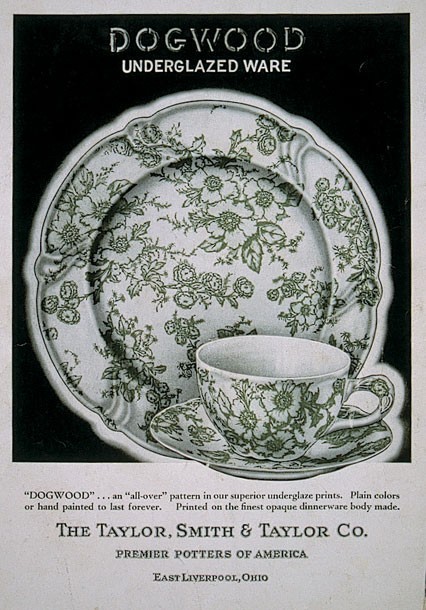
Advertisement, Pottery and Glass Salesman, June 1940, p. 3, for Taylor, Smith & Taylor’s Dogwood Underglazed Ware. (Courtesy, Thorley Papers, Swem Library, College of William and Mary.) Without this confirming ad, one might question the name, as the flowers seem to be more like primroses than dogwood flowers, which have four petals.
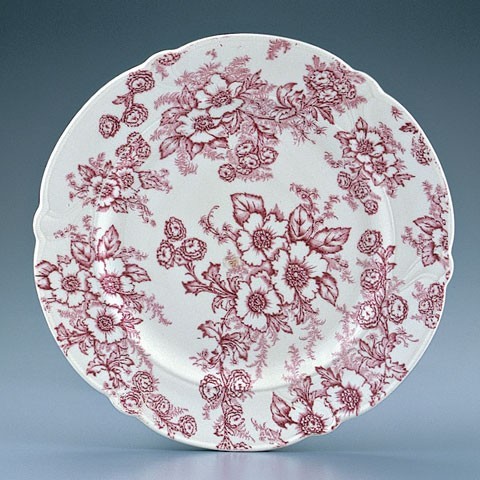
Dogwood dinner plate, Taylor, Smith & Taylor, Chester, West Virginia, 1941. Whiteware. D. 9". Marks: “Taylor, Smith & Taylor, U.S.A.” within a wreath, and “1941.” This plate is decorated with Thorley’s Dogwood decoration on his Vogue shape. (Courtesy, Clark Taggart Collection.)
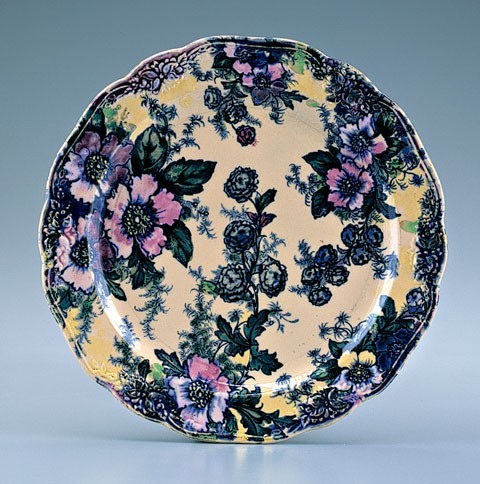
Dogwood bread-and-butter plate, Taylor, Smith & Taylor, Chester, West Virginia, 1933–1950. Whiteware. D. 6⁄÷™". Marks: None. (Courtesy, Clark Taggart Collection.) This plate is in the Marvel shape. Thorley’s Dogwood decoration was produced in monochrome, and, in later years, hand-colored highlights were added, giving the effect of a new pattern. Found in Thorley’s studio, this is probably a trial piece for the polychrome concept.

Dogwood bread-and-butter plate, Taylor, Smith & Taylor, Chester, West Virginia, 1933–1950. Whiteware. D. 6⁄÷™". Marks: None. (Courtesy, Clark Taggart Collection.) This plate is in the Marvel shape. Thorley’s Dogwood decoration was produced in monochrome, and, in later years, hand-colored highlights were added, giving the effect of a new pattern. Found in Thorley’s studio, this is probably a trial piece for the polychrome concept.
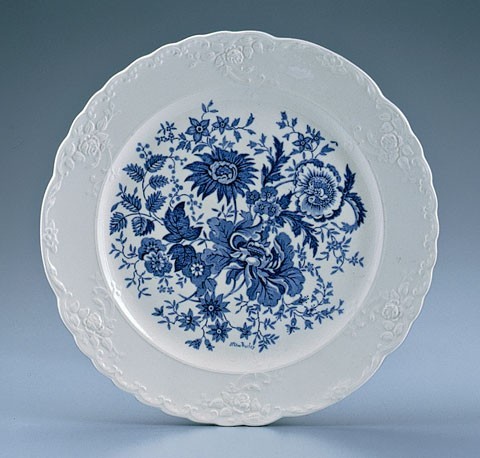
Center Bouquet dinner plate, Taylor, Smith & Taylor, Chester, West Virginia, 1940. Whiteware. D. 9". Marks: “Taylor, Smith & Taylor, U.S.A.” within a wreath; “1940.” This plate is decorated with Thorley’s Center Bouquet design on the Fairway shape, the designer of which has not yet been identified.
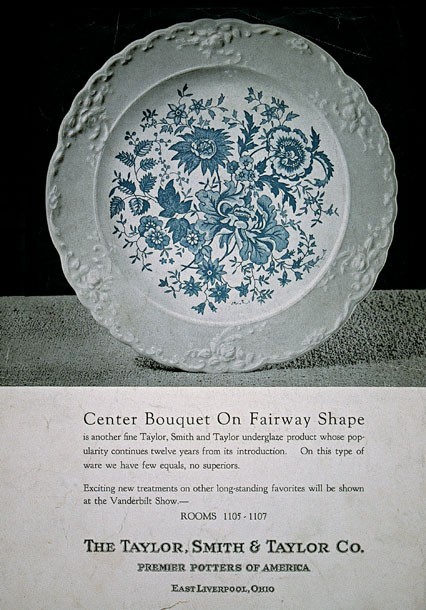
Advertisement for “Center Bouquet on Fairway Shape,” Pottery and Glass Salesman, February 1940, p. 3. (Courtesy, Thorley Papers, Swem Library, College of William and Mary.)
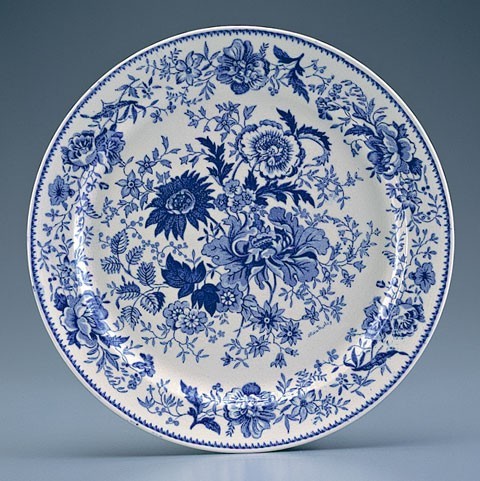
Spring Bouquet dinner plate, Taylor, Smith & Taylor, Chester, West Virginia, 1933–1950. Whiteware. D. 9". Marks: “Taylor, Smith & Taylor, U.S.A.” within a wreath; “1941.” A dinner plate in Thorley’s Spring Bouquet design (bearing his signature) and on his Laurel shape. The central transfer design on Thorley’s Spring Bouquet is identical to that on his Center Bouquet. In addition, this pattern utilizes a second transfer covering the rim. This decoration could be used only on Thorley’s Laurel shape, which is the only one without raised molded decoration on the rim.

Silk screen used by Palin Thorley in Williamsburg, ca. 1955. (Courtesy, Thorley Papers, Swem Library, College of William and Mary.) The color print would have been done in monochrome, with details, if desired, painted in by hand.
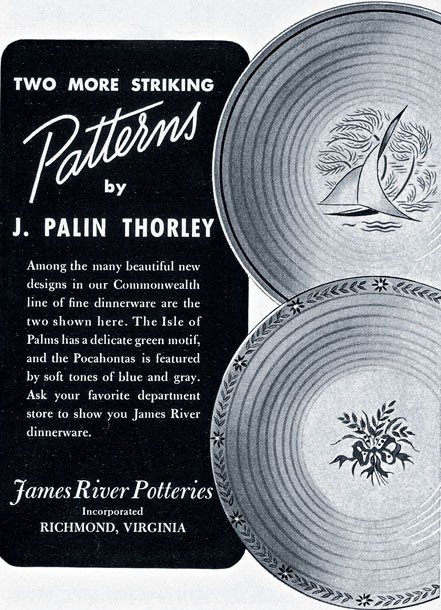
Advertisement, “Two More Striking Patterns by J. Palin Thorley, James River Potteries,” House and Garden, November 1937, p. 124. In this ad the manufacturer credits two patterns to Thorley: Isle of Palms and Pocahontas.
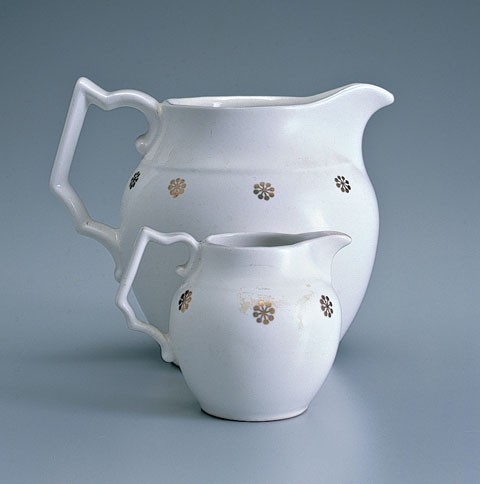
Jugs, Hall China, East Liverpool, Ohio, 1940–1950. Whiteware. Front: H. 3 1/4". Mark: “Hall [within a circle] / MADE IN U.S.A. / 1536.” Rear: H. 5 1/2". Mark: “Hall [within a circle] / MADE IN U.S.A. / 1540.” Thorley Jugs, as they are called, were designed by Thorley and made for Hall in the 1940s. They were made in three sizes, the largest and smallest of which appear here; the middle-size jug is 5" tall and bears the number “1538.” All are the same form as the luster examples Thorley made for Colonial Williamsburg between 1938 and 1955, and appeared with many types of decoration for the rest of his active life.

Refrigerator water jug, Hall China, East Liverpool, Ohio, ca. 1935. Whiteware. H. 8 1/2". Mark: “Made Exclusively for WESTINGHOUSE By / The Hall China Co. MADE IN U.S.A.” During the 1930s Hall produced a series of ware for Westinghouse and other companies designed for use in refrigerators, a popular new appliance. In addition to water jugs, containers for “leftovers” were made in a large variety of shapes and sizes; most came in solid colors. A drawing book among the Thorley Papers illustrates what appears to be a series of these containers in forms reminiscent of those produced by Hall. In May 2000 the Metropolitan Museum of Art, New York, presented “American Modern, 1925–1940: Design for a New Age,” an exhibition that included a related Hall/Westinghouse refrigerator water jug attributed to Thorley, which was dated to 1940.
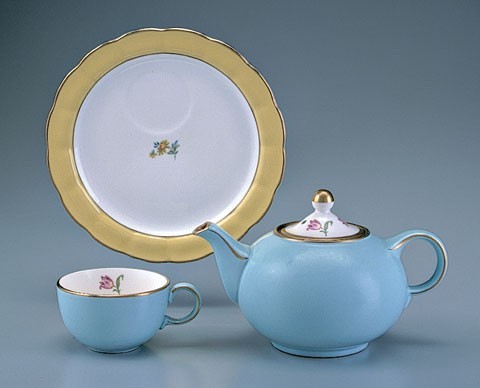
Teapot, cup, and plate with ring for cup, Hall China, East Liverpool, Ohio, ca. 1945. Whiteware. H. of teapot 4 1/2", D. of cup 2", D. of plate 7 1/2". Marks: (teapot) “HALL CHINA / SET NO. 1 / BLUE BELL”; (cup) “HALL CHINA / SET NO. 1 / BLUE BELL / DEC.[for decoration] 80 PINK”; (plate) “HALL CHINA / SET NO. 2 / BUTTERCUP / DEC. 80 YELLOW.” The final color given as part of the mark—“PINK,” “YELLOW,” and “BLUE” (not shown)—refers to the small flowers. It is likely that these pieces were designed by Thorley because they were found in his studio attic with other examples, all of which are confirmed to have been made at potteries where he had worked and many of which are confirmed as his designs. Moreover, bills for the purchase of these and E-shape wares known to have been designed by Thorley show that these items were sold to him at a very low price (25 percent of list), whereas other pieces he purchased were sold to him at 50 percent of list price. Thorley ordered examples of these in the 1950s, presumably to sell in his shop.

Sears Roebuck catalog, fall-winter 1942–1943, p. 718.
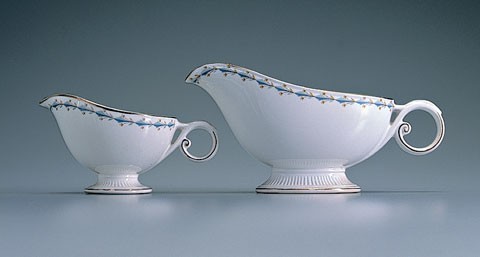
Mount Vernon creamer and sauceboat, Hall China, East Liverpool, Ohio, 1940–. Whiteware. Creamer: H. 3 1/4", L. 6"; sauceboat: H. 4 1/2", L. 9". Another E-shape design by Thorley, these pieces were sold exclusively through Sears Roebuck Co.
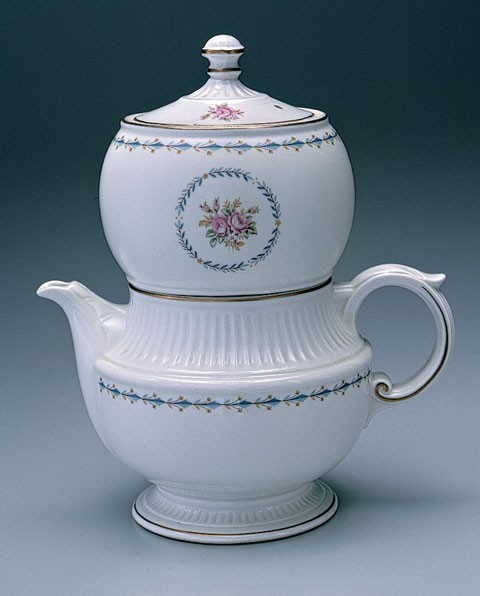
Coffee maker, Hall China, East Liverpool, Ohio, 1942–1948. Whiteware. H. 11 1/2". This form, designed for brewing drip coffee, appeared in the Sears catalogs about ten years after Thorley designed the E-shape. Drawings for coffee makers in various forms appear in the Thorley papers. Mount Vernon was the only pattern used on the E-shape. The “coffee maker and 100 paper filters sold for $2.89” in the Sears catalog; see Margaret Whitmyer and Kenn Whitmyer, Collector’s Encyclopedia of Hall China (Paducah, Ky.: Collector Books, 2001), p. 95.

Richmond sugar bowl, Hall China, East Liverpool, Ohio, 1941–1960. Whiteware. H. 4 1/2". Often called the Black-eyed Susan pattern, this E-shape bowl was offered for sale in the Sears Roebuck catalogs.

Monticello berry bowl, Hall China, East Liverpool, Ohio, 1940–. Whiteware. D. 5". Mark: Harmony House, including pattern name (Monticello) and manufacturer (Hall). This bowl illustrates the Monticello pattern and the E-shape. It is not known whether Thorley was responsible for the decoration or just the shape. The three patterns originally used on Thorley’s E-shape and offered in the Sears Roebuck catalogs of the early 1940s are Monticello, Mount Vernon (fig. 66), and Richmond (fig. 68).
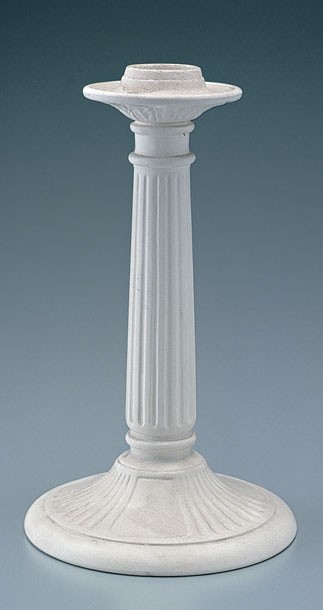
Candlestick, Hall China, East Liverpool, Ohio, 1940–1960. Whiteware. H. 9". (Courtesy, Clark Taggart Collection.) This form was offered by Sears to complement the E-shape dinnerware; they are illustrated together in the Sears catalogs. This unglazed and unmarked example was discovered in Thorley’s studio in 1986.
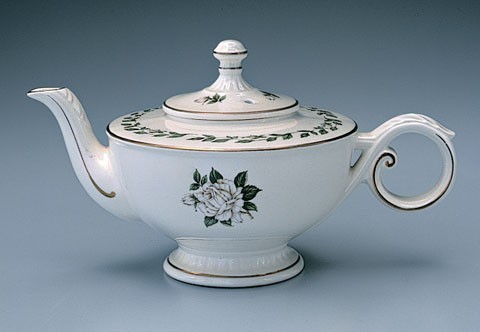
Cameo Rose teapot, Hall China, East Liverpool, Ohio, ca. 1960. Whiteware. H. 5 1/2". As with most dinner services, for which the most elaborate piece is usually the soup tureen, in a tea service the teapot generally dominates the table. Thorley’s E-shape teapot, seen here in the Cameo Rose pattern, is no exception. With its large coiling handle this is the most elegant of all the teapots made by Hall in the middle of the last century, and the pattern was sold exclusively through Jewel Tea Company from 1951 into the 1970s.

A color reproduction from a later Sears catalog—found in the Thorley Papers but without a date or page number—illustrates the same three patterns, again coupling the dinnerware with the candlestick. (Courtesy, Thorley Papers, Swem Library, College of William and Mary.)

Fairfax cereal bowl, Hall China, East Liverpool, Ohio, 1941–1959. Whiteware. D. 7". This Fairfax example in Thorley’s E-shape is one of at least five patterns that could be purchased from Hall China by any retailer.

Flyer illustrating six teapots designed by Thorley that predates 1958. (Courtesy, Thorley Papers, Swem Library, College of William and Mary.)
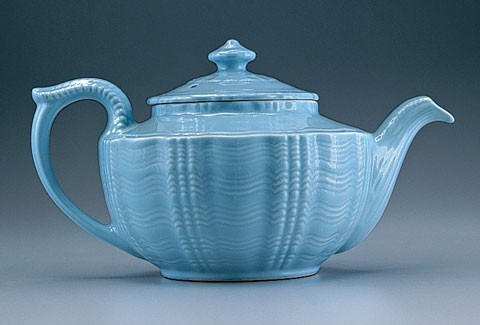
Teapots, Hall China, East Liverpool, Ohio, 1945–1960. Whiteware. H. each 5". These two teapots were designed by Thorley, according to the flyer illustrated in fig. 74 from a series usually referred to as Victorian Style. The Plume shape is colored in Tea Rose and the Birch shape is colored in Blue Mist. A 1947 ad states that they were sold by the Jewel Tea Co. for $1.75 each (Whitmyer and Whitmyer, Collector’s Encyclopedia of Hall China, p. 202).
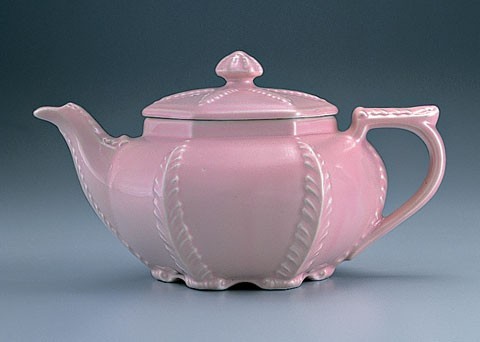
Teapots, Hall China, East Liverpool, Ohio, 1945–1960. Whiteware. H. each 5". These two teapots were designed by Thorley, according to the flyer illustrated in fig. 74 from a series usually referred to as Victorian Style. The Plume shape is colored in Tea Rose and the Birch shape is colored in Blue Mist. A 1947 ad states that they were sold by the Jewel Tea Co. for $1.75 each (Whitmyer and Whitmyer, Collector’s Encyclopedia of Hall China, p. 202).

Other flyers illustrating Hall China teapots. (Courtesy, Thorley Papers, Swem Library, College of William and Mary.) The designers of these teapots are not specified, but the flyers were sent to Thorley in March 1958 along with letters and notes from Joe Thompson of Hall China Co. The center one is dated 1958; the other two are dated 1956.

Other flyers illustrating Hall China teapots. (Courtesy, Thorley Papers, Swem Library, College of William and Mary.) The designers of these teapots are not specified, but the flyers were sent to Thorley in March 1958 along with letters and notes from Joe Thompson of Hall China Co. The center one is dated 1958; the other two are dated 1956.
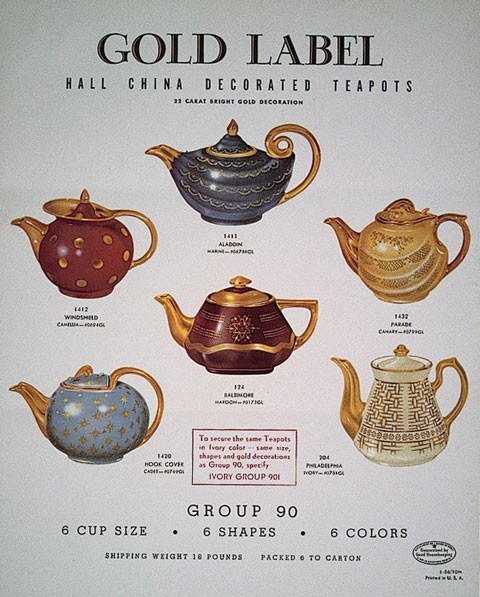
Other flyers illustrating Hall China teapots. (Courtesy, Thorley Papers, Swem Library, College of William and Mary.) The designers of these teapots are not specified, but the flyers were sent to Thorley in March 1958 along with letters and notes from Joe Thompson of Hall China Co. The center one is dated 1958; the other two are dated 1956.

Teapot, Hall China, East Liverpool, Ohio, ca. 1960. Whiteware. H.7 1/2". This teapot has a gilded grape design that is studded with rhinestones. The inclusion of rhinestones, suggested by Joe Thompson of Hall China Co., can be found on several of Thorley’s teapot models. The bottom has several marks including “HALL” within a circle, “MADE IN U.S.A. 1528” in blue, and “HALL, 6 CUP MADE IN U.S.A. 0917” in gold.

Cookie jar and mixing bowls, Hall China, East Liverpool, Ohio, ca. 1960. H. of cookie jar: 6 1/2". D. of bowls: 8 1/2," 7 1/2," and 6 1/4". These objects have Thorley’s gilded grape design, but without the rhinestones. Note the original shipping boxes. Mark on all four pieces: “HALL'S SUPERIOR QUALITY KITCHENWARE Made in U.S.A."
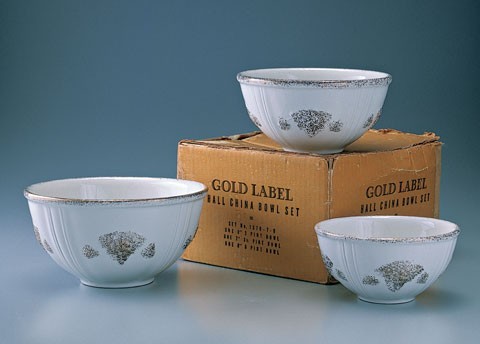
Cookie jar and mixing bowls, Hall China, East Liverpool, Ohio, ca. 1960. H. of cookie jar: 6 1/2". D. of bowls: 8 1/2," 7 1/2," and 6 1/4". These objects have Thorley’s gilded grape design, but without the rhinestones. Note the original shipping boxes. Mark on all four pieces: “HALL'S SUPERIOR QUALITY KITCHENWARE Made in U.S.A.
